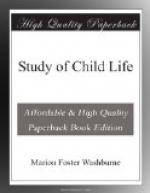[Sidenote: Precocity]
[Sidenote: Early Ripening]
In all these things some children develop earlier than others, but too early development is to be regretted. Precocious children are always of a delicate nervous organization. Fiske[D] has proved to us that the reason why the human young is so far more helpless and dependent than the young of any other species is because the activities of the human race have become so many, so widely varied, and so complex, that they could not fix themselves in the nervous structure before birth. There a only a few things that the chick needs to know in order to lead a successful chicken life; as a consequence these few things are well impressed upon the small brain before ever he chips the shell; but the baby needs to learn a great many things—so many that there is no time or room to implant them before birth, or indeed, in the few years immediately succeeding birth. To hurry the development, therefore, of certain few of these faculties, like the faculties of talking, and walking, of imitation or response, is to crowd out many other faculties perhaps just beginning to grow. Such forcing will limit the child’s future development to the few faculties whose growth is thus early stimulated. Precocity in a child, therefore, is a thing to be deplored. His early ripening foretells a early decay and a wise mother is she who gives her child ample opportunity for growing, but no urging.
[Sidenote: Ample Opporunity for Growth]
Ample opportunity for growth includes (1) Wholesome surroundings, (2) Sufficient sleep, (3) Proper clothing, (4) Nourishing food. We will take up these topics in order.
[Footnote A: W. Preyer. Professor of Physiology, of Jena, author of “The Mind of the Child.” D. Appleton & Co.]
[Footnote B: Dr. Robinson. Physician and Evolutionist, paper in The Eclectic, Vol. 29.]
[Footnote C: Miss Millicent Shinn, American Psychologist, author of “Biography of a Baby.”]
[Footnote D: John Fiske, writer on Evolutionary Philosophy. His theory of infancy is perhaps his most important contribution to science.]
WHOLESOME SURROUNDINGS
The whole house in which the child lives ought to be well warmed and equally well aired. Sunlight also is necessary to his well-being. If it is impossible to have this in every room, as sometimes happens in city homes, at least the nursery must have it. In the central States of the Union plants and trees exposed to the southern sun put forth their leaves two weeks sooner than those exposed to the north. The infant cannot fail to profit by the same condition, for the young child may be said to lead in part a vegetative as well as an animal life, and to need air and sunshine and warmth as much as plants do. The very best room in the house is not too good for the nursery, for in no other room is such important and delicate work being done.




